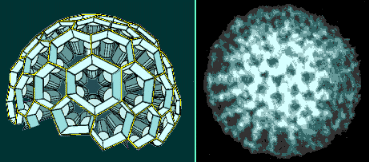Rotaviruses infect the lining of the intestine and cause diarrhoea, especially in children.
Rotavirus particles are approximately 75nm in diameter. They have icosahedral symmetry and particles possess two concentric protein shells, or capsids. The term "rota", meaning wheel, is derived from the appearance of the complete double-capsid particle when viewed by negative staining in a position where the 5-fold axis of symmetry is acentric. Apparent spoke-like components are then visible on one side of the virus particle.
A double-capsid particle is shown on the left, and the single (inner) capsid on its right.
The arrangement of capsomers on the inner capsid gives the appearance of a lattice - 5 capsomers surround a space at each apex (5-fold axis)
The inner capsid
A drawing depicts the apparent arrangement of capsomers on the inner capsid, and is shown side-by-side with a colourised EM image. Lines denote the 5-fold axes of symmetry.
The outer capsid
The outer capsid is positioned upon the virion in such a way that the capsomeres of each capsid layer co-incide.
© Copyright Dr Linda M Stannard, 1995
This page was written by Dr Linda Stannard, on behalf of the Division of Medical Virology, UCT.
In Memory of Dr Linda Stannard, 10 May 1942 - 17 October 2016
For re-use of and queries about Dr Stannard's images, please contact Dr Stephen Korsman at stephen.korsman@uct.ac.za.
Recipient of Key Resource Award



